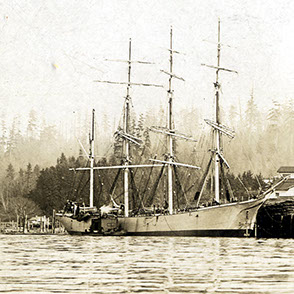 In 1891, the long anticipated Great Northern railroad reached Mukilteo and once more hopes soared among the 300 or so residents that their tiny village would become the next big boom town on Puget Sound. Frost and Fowler, founders of Mukilteo, had tried repeatedly to build on the logging and associated wood processing base to provide greater financial stability: cranberry exports and shipbuilding in the 1860s, salmon-salting in 1870, salmon-canning in 1877 (the first on Puget Sound), lager beer brewing in 1875, and many other minor ventures. Whether it was accidental fires, unusually heavy snow, mismanagement, or fickle markets, none of the efforts achieved sustained success. Even the new railroad seemed to boost Everett and Seattle far more than the “whistle-stop” town of Mukilteo.
In 1891, the long anticipated Great Northern railroad reached Mukilteo and once more hopes soared among the 300 or so residents that their tiny village would become the next big boom town on Puget Sound. Frost and Fowler, founders of Mukilteo, had tried repeatedly to build on the logging and associated wood processing base to provide greater financial stability: cranberry exports and shipbuilding in the 1860s, salmon-salting in 1870, salmon-canning in 1877 (the first on Puget Sound), lager beer brewing in 1875, and many other minor ventures. Whether it was accidental fires, unusually heavy snow, mismanagement, or fickle markets, none of the efforts achieved sustained success. Even the new railroad seemed to boost Everett and Seattle far more than the “whistle-stop” town of Mukilteo.
So it was once again logging and milling that continued to be the backbone of Mukilteo’s economy. In 1903, a lumber company was begun a few blocks north along the shore that very quickly became one of the largest on Puget Sound. By 1910, the Crown Lumber Company was turning out 200,000 board-feet of lumber every day, much of it being shipped from the town’s deep-water port to San Francisco after its disastrous 1906 earthquake and fire. Other sailing vessels and steamships sailed by this shore on their way to Pacific Rim countries, particularly Japan. Interestingly, about half the labor force of the Crown Lumber Company were immigrants from Japan, even as the company exported the fruits of their labor back to their home country. In 1906, the year the Mukilteo Lighthouse began operations, the Puget Sound and Alaska Powder Company set up a major plant near Mukilteo and soon the ships passing by this beach contained explosives for mining activities up and down the coast.
But the persistent search for sustained prosperity failed again in Mukilteo, seemingly in one single week of disasters. In September, 1930, the powder plant exploded, Crown Lumber closed its doors due to declining sales and increasing costs, and a major train wreck on the nearby railroad suspended operations for weeks. Prosperity remained elusive in Mukilteo until the boom created by World War II when military activities in the area led to a surge in development and employment. The navy built a long pier along the north shore that made Mukilteo one of the largest ammunition-loading operations in the United States. Four large ships could be loaded simultaneously and the operations were often run around the clock. Even Russian vessels came to be supplied under the American lend-lease program. So once again the waters just off the shore here featured the passage of many ships, only the cargo this time was much more lethal.
Copyright 2015, Mukilteo Walking Tour. All rights reserved.